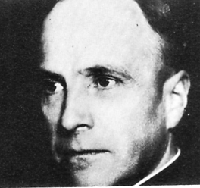The command structure of the German Army was a major factor in the success of their attack on France in May 1940. Likewise, the command structure of the Allies at the start of World War Two can be linked to their rapid defeat.
|
Field Marshall von Brauchitsch |
The Wehrmacht (German Army) had a simple and easy to understand command structure. At the top of the German Army was Hitler who had appointed himself Supreme Commander of the Armed Forces. Though Hitler paid a keen interest in what the Wehrmacht did, at this stage in the war, he did not interfere in decision making once a campaign had started (though he had been the main force behind an attack on Western Europe). The commander-in-chief of the Army High Command was Field Marshall von Brauchitsch and under him, there were three generals commanding various army groups; Rundstedt (Army Group A), Bock (Army Group B) and Leeb (Army Group C).
The high command of the army was the Oberkammando des Heeres (OKH). The Luftwaffe (air force) was similarly organised with the Oberkammando der Luftwaffe (OKL) and the navy had the Oberkammando der Kriegsmarine (OKM).
One of the reasons for Germany’s success in May 1940 was that it had a unified command structure with each unit of the military acting to support the other – hence the importance of the Luftwaffe to the success of blitzkrieg.
However, the same was true of the Allies. The Germans had the advantage that they were a unified force – one nation with one command structure. The Allies prior to the May 10th attack, had four – the Dutch, Belgium, French and British. The Dutch and Belgium governments wanted to maintain their neutrality for as long as was possible. Therefore the staff commands of both countries were not allowed to contact the staff commands of the British or French. If either Belgium or the Netherlands had to defend themselves, they had their own plans as there was no co-ordination between themselves or the stronger military powers in the west of Europe.
The Netherlands and Belgium were also entirely separated from the British and French as no movement of anything military was allowed across their national borders without a formal invitation – and this was not issued in the days leading up to May 10th – out of fear of provoking a German response. When it was issued, Germany was already on the attack.
Even the French and British did not have an integrated command structure – in the proper sense of the word. Lord Gort, head of the BEF, was under the command of the French military in theory. In reality, his command of the BEF meant that he was a commander in his own right and had a degree of independence from the French.
The French command structure within France “was a peculiar one” (Major-General R Barry). The Chief of Staff Armed Forces was General Gamelin. He was responsible for the defence of France on all fronts – including overseas territories. The so-called “North-East Front”, bordering Belgium and Germany was under the command of General Georges. This front, understandably, contained a great deal of the French army in the months leading up to May 10th. Gamelin had his headquarters just outside of Paris at Vincennes. Georges had his headquarters at La Ferté-sous-Jouarre, about 40 miles east of Paris. In the spring of 1940, both of these highly important military centres were linked by a single staff located at Montry, about 20 miles from Vincennes and about the same distance from Georges’ headquarters. The Chief-of-Staff, General Doumenc tried to spend an equal amount of time at both centres.
The commander of the French Air Force, General Vuillemin, had his headquarters elsewhere. The air force divided France up into ‘zones of operations’ but the pilots within each could receive instructions from Vuillemin or from the Air Observation Groups which were attached to the army. There is evidence that the air force received contradictory instructions from both once the Germans had attacked.
The most senior military figure in Belgium was the king, Leopold. He was commander-in-chief of the Belgium Army. However, he took advice from his military advisor, General van Overstraeten rather than from his General Staff. Belgium put its defensive trust in the Albert Canal, running north-west from Liège to Antwerp. Liège as a city was heavily fortified; Fort Eben-Emael was considered to be the strongest fort in the whole of Europe and the city was considered to be the linchpin of the whole defence plan of Belgium. However, such planning also meant that if Liège fell, then Belgium would also fall.
